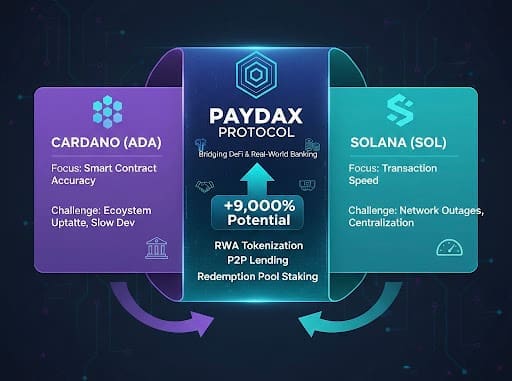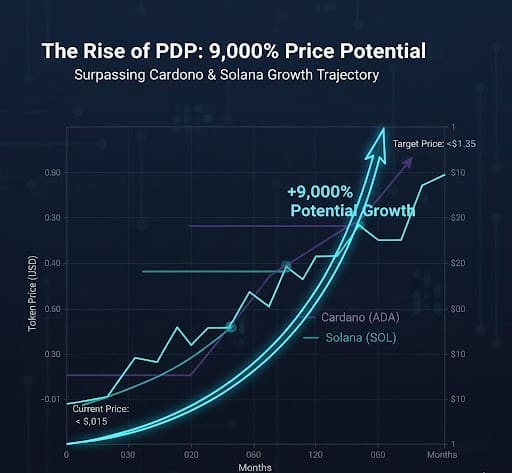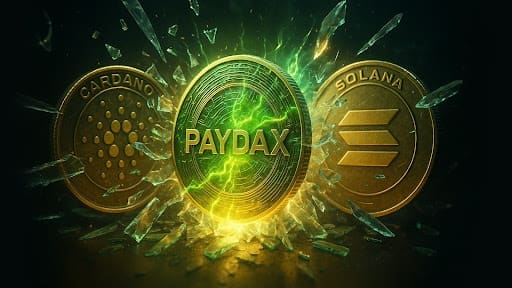Traditional blockchains are struggling. It’s a strong claim to make, but the crypto market’s constant flux for the past few months points to some underlying flaws that are only coming to the fore. Cardano (ADA) and Solana (SOL), in particular, have been on a plateau recently. Cardano’s slowed adoption and Solana’s centralization struggles have failed to deliver more upside for their loyalists.
DeFi’s liquidity problem adds fuel to the fire. Many crypto traders hold tokens valued in the millions but have no way to unlock actual liquidity without selling their holdings and sacrificing their exposure to yield opportunities. Paydax Protocol, a new project fondly dubbed “The People’s DeFi Bank,” has risen to the occasion with a uniquely designed infrastructure that allows users to unlock the value of their idle crypto and RWA assets. Its native token, PDP, has likewise become the darling of profit-hunters and is poised to surpass Cardano (ADA) and Solana (SOL), as leading analysts predict a whopping 9,000% rally for the banking token.
From Blockchain To Banking
Despite being regarded as top-tier layer-1 networks, Cardano (ADA) and Solana (SOL) are battling some major obstacles. Solana (SOL) struggles with network interruptions and centralization issues, while Cardano (ADA) has faced ecosystem uptake challenges and delayed development, effectively slowing its adoption below projections.
Meanwhile, Paydax protocol presents a hybrid strategy intended to connect both innovation and practical application. While industry leaders like Cardano (ADA) concentrate on smart contract accuracy and Solana (SOL) distinguish themselves by transaction speed, Paydax Protocol and its native token, PDP, are working on creating infrastructure that serves everyday traders and bridges DeFi with the real world. This positions Paydax Protocol as the foundation of international digital banking in the future, a market that neither Cardano (ADA) nor Solana (SOL) has entirely tapped.
In turn, the platform’s native banking token, PDP, is being positioned for extensive utility and a radical demand cycle that could pit it against even powerful cryptocurrencies like Cardano and Solana. Trading at under $0.015, the banking token is already pegged by leading analysts for a 9,000% rally, possibly outpacing Cardano (ADA) and Solana (SOL) in terms of adoption and growth.

The New Edge In DeFi: Where Real-World Utility Meets Blockchain Finance
There is much more to the PDP token than just another cryptocurrency fad. Paydax Protocol puts its usability first, in contrast to Cardano (ADA) or Solana (SOL). Users can tokenize conventional assets like equities and real estate, earn returns on deposits, and make rapid cross-border payments using its banking token model, all without ever leaving the blockchain. Guess what fuels all of those operations—PDP.
While Solana (SOL) prioritizes transaction speed and scalability, and Cardano (ADA) concentrates on layered smart contracts, neither platform has completely integrated a borrowing mechanism that connects physical assets to DeFi loans. Since the Cardano (ADA) ecosystem is still in its infancy, asset tokenization must be handled by third-party dApps. Despite its efficiency, Solana (SOL) places more emphasis on high-frequency DeFi trading than on a variety of borrowing choices. In stark contrast, Paydax Protocol’s adoption of this strategy positions its native banking token as a secure financial bridge, connecting Web3 liquidity with real economic activity.
For instance, in a scenario where a user owns Solana (SOL) or Cardano (ADA) tokens worth $100,000, they can borrow 80,000 USDT while using the Solana (SOL) as collateral locked in a DeFi vault. Once they pay off the loan of 80,000 USDT, their Solana (SOL) or Cardano (ADA) is returned, so they retain ownership and yield exposure.
Unleashing Explosive Growth
Since Cardano (ADA) and Solana (SOL) both had gains of over 10,000% during their breakout cycles, Paydax Protocol’s PDP has good potential to be the next banking token to revolutionize DeFi. The token is currently in a critical accumulation phase, with a price below $0.015 and prospects of increasing to $0.017 or higher in the coming presale rounds, having raised about $1 million.
According to analysts, industry players will recognize the Paydax Protocol and its banking token’s value proposition as the first fully functional DeFi bank with RWA integration, transforming DeFi activity into actual liquidity through its banking token. PDP would be on par with Cardano (ADA) and Solana (SOL) during their early periods of exponential growth if it rallies 9,000% from its current levels.

The Dawn Of The Banking Token Revolution
The world of cryptocurrencies is shifting from speculation to useful financial integration. Paydax Protocol exemplifies that shift by establishing a niche that Cardano (ADA) and Solana (SOL) have not yet occupied, focusing on the nexus between blockchain and banking.
If forecasts come to pass, PDP might spark one of the most spectacular cryptocurrency rallies in recent memory, turning this banking token from a small player trading at $0.015 into a dominant force that completely changes the way the world views blockchain-based banking. Using the promo code PD25BONUS, early investors receive a special 25% incentive today. Without a doubt, there is no better time to invest heavily in PDP before the bull wave occurs.
Own the Future—Join the Presale Before It Explodes!
Website: https://pdprotocol.com/
Telegram: https://t.me/PaydaxCommunity
X (Twitter): https://x.com/Paydaxofficial
Whitepaper: https://paydax.gitbook.io/paydax-whitepaper



